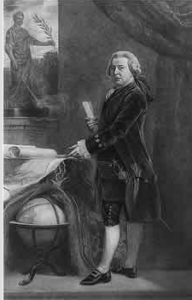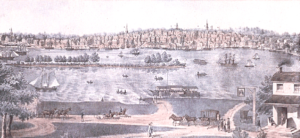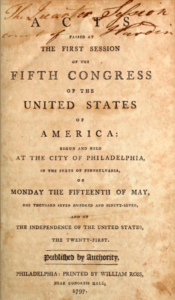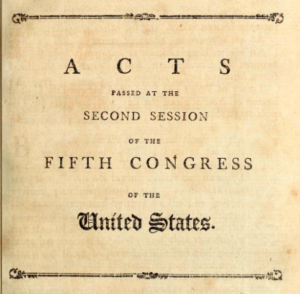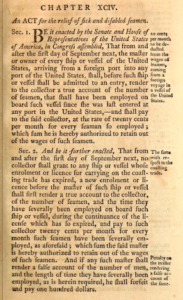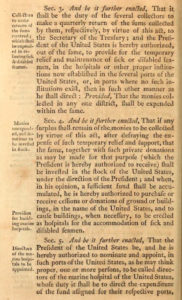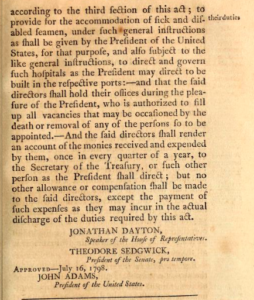Hamilton’s Report on Marine Hospitals and the Act for the Relief of Sick and Disabled Seamen, April 17, 1792
[5th Congress, Second Sess, Ch. 77 1798, July 16, 1798; 1 Stat. 605]
Click here for a link to Hamilton’s Report on Marine Hospitals
Click here for a link to the Act
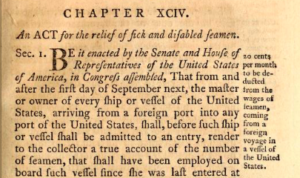
In the late 1790’s a series of deadly Yellow Fever outbreaks afflicted several American coastal cities. Recognizing that the illness was somehow associated with and possibly spread by sailors, Congress enacted an Act for the Relief of Sick and Disabled Seamen in July of 1798. The Act was the first federal social insurance program (the “Marine Hospital Service”) and the forerunner of the U.S. Public Health Service.
Originally, the proposal to provide health care to sick and disabled sailors had been officially recommended by Alexander Hamilton in 1792, upon the suggestion of the Marine Society of Boston.
According to Hamilton, the creation of hospitals for sailors would be desirable for several reasons:
The establishment of one or more marine Hospitals in the United States is a measure desirable on various accounts. The interests of humanity are concerned in it, from its tendency to protect from want and misery, a very useful, and, for the most part, a very needy class of the Community. The interests of navigation and trade are also concerned in it, from the protection and relief, which it is calculated to afford to the same class; conducing to attract and attach seamen to the country
Hamilton described the mechanism of how the proposal would work as follows, with a payroll contribution rate of 10 cents per month:
A fund for the purpose may, it is presumed, be most conveniently derived from the expedient suggested in the above mentioned Memorial, namely, a contribution by the mariners and seamen of the United States, out of their wages to be regulated by law.
The rate of the contribution may be ten cents per month for each mariner or seamen, to be reserved, pursuant to articles, by masters of vessels, and paid to the collectors of districts, to which the vessels respectively belong. Effectual regulations for this purpose may, without difficulty be devised.
Hamilton further explained that the fund could be extended to cover widow’s and children of seamen killed on the job.
The benefit of the fund ought to extend, not only to disabled and decrepid seamen, but to the widows and children of those who may have been killed or drowned, in the course of their service as seamen.
It will probably be found expedient, besides the reception and accomodation of the parties entitled, at any hospital which may be instituted to authorize the granting pensions, in aid of those who may be in condition, partly to procure a subsistence from their own labor. There may be cases, in which this mode of relief may be more accommodating to the individuals, and, at the same time, more economical.
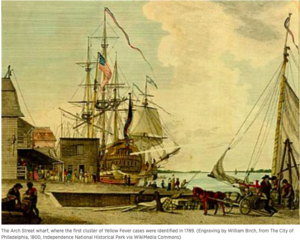
In his first State of the Union address of November 22, 1797, President John Adams described “the contagious sickness which afflicted the city of Philadelphia.” Click here for a link to Adams’ first address to Congress in 1797. Adams mentioned that he had even considered convening Congress at another location but declined to do so because it would occasion “much public inconvenience and a considerable public expense and add to the calamities of the inhabitants of this city [Philadelphia]”, which was the temporary capital while Washington, D.C was being built. For a link to the Residence Act, which temporarily moved the Capital from New York to Philadelphia while Washington, D.C. was being constructed, click here.
The Act for the Relief of Sick and Disabled Seamen provided for the collection of 20 cents per month (America’s first federal payroll tax) for each sailor on arriving ships in U.S. ports, to be deposited with the Secretary of the Treasury. The next year, Congress extended the Act to cover all sailors in the U.S. Navy and provided for a Navy pension of half pay for all Navy officers and seamen disabled in the line of duty. Click here for a link to the 1799 Act, Ch. 24, Fifth Congress, 3rd Session. The two Acts resulted in the creation of a national system of marine hospitals. As the country expanded, the Acts were extended by Henry Clay to cover inland port cities along the Ohio and Mississippi Rivers. The program eventually became the Public Health Service which still exists today under the supervision of the Surgeon General.
By today’s standards, the simple, five section Act provided as follows:
Section 1 imposed the mandatory 20 cent per month payroll tax, to be collected from “the master or ownerof every ship or vessel of the United States, arriving from a foreign port into any port of theUnited States.” Recognizing that it would take time for the Treasury Department to imitate the new national program, Congress provided for slightly over a year for the law to take effect, beginning on the “first day of September next.”
Section 2 provided for an enforcement mechanism, including fines of $100 if a ship’s master rendered “a false account of the number of men, and the length of time they have severally been employed.”
Section 3 required that all withheld taxes be turned over to the Secretary of the Treasury on a quarterly basis. The President was authorized “to provide for the temporary relief and maintenance of sick, or disabled seamen, in the hospitals or other proper institutionsnow established in the several ports of the United States, or in ports where no such institutionsexist, then in such other manner as he shall direct.” The only limitation on the President’s discretion was the requirement that “moneys collected in anyone district, shall be expended within the same.”
Section 4 addressed surplus funds which were dedicated for the construction of marine hospitals, along with voluntary private donations the President was authorized to receive as follows: “That if any surplus shall remain of the moneys to be collected by virtue of this act, afterdefraying the expense of such temporary relief and support, that the same, together with suchprivate donations as may be made for that purpose, (which the president is hereby authorized toreceive,) shall be invested in the stock of the United States, under the direction of the president;and when, in his opinion, a sufficient fund shall be accumulated, he is hereby authorized topurchase or receive cessions or donations of ground or buildings, in the name of the UnitedStates, and to cause buildings, when necessary, to be erected as hospitals for the accommodationof sick and disabled seamen.”
Section 5 authorized the President to appoint hospital directors who would serve at the pleasure of the President. The directors were required to make quarterly reports to the Secretary of the Treasury.
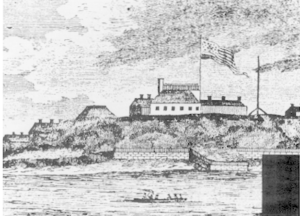 Background: The concept of a system of hospitals to care for merchant seamen was based on the British model. England established its first hospitals for sailors in 1588, after its victory over the Spanish Armada.
Background: The concept of a system of hospitals to care for merchant seamen was based on the British model. England established its first hospitals for sailors in 1588, after its victory over the Spanish Armada.
After the Act’s adoption in 1798, Castle Island in Boston Harbor was chosen as the site for the first federal marine hospital (which is pictured here). In 1799, Dr. Thomas Welsh, a participant in the battles of both Lexington and Bunker Hill, was appointed as the physician in charge.
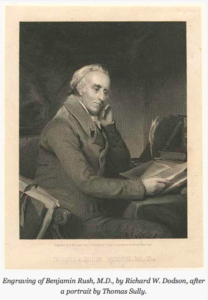 It is estimated that 5,000 people died of Yellow Fever in New York, Philadelphia, and Boston in the summer of 1798. At the time, Yellow Fever was considered a disease of the tropics. It took the lives of many sailors traveling to the West Indies, one of America’s principal trading partners. Dr. Benjamin Rush was the first to recognize that the epidemic was Yellow Fever.
It is estimated that 5,000 people died of Yellow Fever in New York, Philadelphia, and Boston in the summer of 1798. At the time, Yellow Fever was considered a disease of the tropics. It took the lives of many sailors traveling to the West Indies, one of America’s principal trading partners. Dr. Benjamin Rush was the first to recognize that the epidemic was Yellow Fever.
In his December 8, 1798 Second Annual Address to Congress, John Adams described the “alarming and destructive pestilence” which had impacted several coastal cities. He called on Congress to “frame a system” and establish “suitable regulations in aid of the health laws of the respective States”:
But when we reflect that this fatal disorder has within a few years made repeated ravages in some of our principal sea ports, and with increased malignancy, and when we consider the magnitude of the evils arising from the interruption of public and private business, whereby the national interests are deeply affected, I think it my duty to invite the Legislature of the Union to examine the expediency of establishing suitable regulations in aid of the health laws of the respective States; for these being formed on the idea that contagious sickness may be communicated through the channels of commerce, there seems to be a necessity that Congress, who alone can regulate trade, should frame a system which, while it may tend to preserve the general health, may be compatible with the interests of commerce and the safety of the revenue.
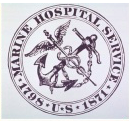 The system of Marine Hospitals under the Act would quickly grow. In 1802, an Act was passed providing $15,000 for the erection of a Marine Hospital in Boston. In February of 1802, Secretary of the Treasury Albert Gallatin reported to Congress that hospitals were operating in Boston, Newport, Norfolk, and Charleston. In the following cities the Treasury Department elected to contract for medical services, but had not yet build federal hospitals: Baltimore, New York, Philadelphia, Portland, New London, Wilmington, New Bern and Edenton (North Carolina), Alexandria, and Savannah. The same year, President Jefferson would suggest that Congress consider building a hospital in New Orleans for seaman. Click here for a link to Jefferson’s February 1802 letter to the Sentate, forwarding Galatin’s report on federal maritime hospitals.
The system of Marine Hospitals under the Act would quickly grow. In 1802, an Act was passed providing $15,000 for the erection of a Marine Hospital in Boston. In February of 1802, Secretary of the Treasury Albert Gallatin reported to Congress that hospitals were operating in Boston, Newport, Norfolk, and Charleston. In the following cities the Treasury Department elected to contract for medical services, but had not yet build federal hospitals: Baltimore, New York, Philadelphia, Portland, New London, Wilmington, New Bern and Edenton (North Carolina), Alexandria, and Savannah. The same year, President Jefferson would suggest that Congress consider building a hospital in New Orleans for seaman. Click here for a link to Jefferson’s February 1802 letter to the Sentate, forwarding Galatin’s report on federal maritime hospitals.
Post script: It would later be demonstrated that Yellow Fever is a virus spread by the Aedes aegypti mosquito. In 1951, Max Theiler was awarded the Nobel Prize in Medicine for his discovery a Yellow Fever vaccine.
The first American medical journal, The Medical Repository, was published in July of 1797. President Jefferson personally campaigned for smallpox vaccination which became common by the end of his presidency.
President Roosevelt brought together federal programs addressing health and social welfare, including the Public Health Service, when he created the Federal Security Agency (FSA) in 1939. In 1953, the FSA was raised to a cabinet-level agency and became the Department of Health, Education, and Welfare. The Department was later reorganized as the Department of Health and Human Services (DHS). The Public Health System remains a part of DHS today.
After the Patient Protection and Affordable Care Act was adopted in 2010, the Act for the Relief of Sick and Disabled Seamen attracted national attention as a precedent that arguably provides support for the concept of a health insurance mandate. Here are some articles debating the question:
Pictured below is President Adams and Philadelphia at around the time of the construction of the first Maritime Hospital:
Click here for a link to the Acts of the Fifth Congress, published in 1797 by William Ross
Additional reading and sources:
A Short History of Yellow Fever in the U.S.
State of the Union History blog
History of the Public Health Service (USPHS)
Origins of the National Institutes of Health (NIH)
The Papers of Alexander Hamilton
